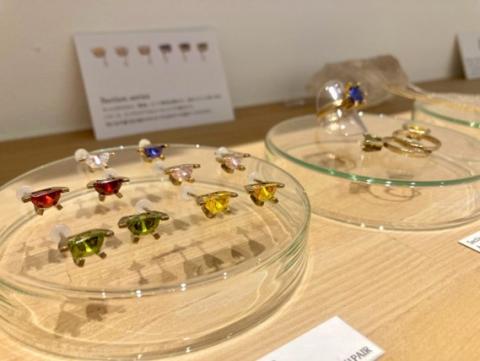Main content starts here.
Off the Beaten Path
Japan is known for its sweltering summers, and the Yamanashi prefecture, located in the Chūbu region, is no exception. Being from Southern California, if it was ever hot outside I would just go to the beach or pool and cool off there. Here in Japan, however, it is not that simple. You’ve got options to stay cool here in Japan, but they aren’t all that exciting; staying cooped up in your room while blasting the AC (quite boring), desperately searching for any bit of shade (I wouldn’t recommend it), or even going to get some ice cream (not a bad idea). If those scenarios don’t sound too enticing, then I want to tell you my experience about how I escaped the summer heat of Japan.
Sightseeing and exploring the Yamanashi area all morning really started to wear me out. The summer heat and exploration fatigue are a dangerous combo. I really just wanted to get back home, wash the day off of me, and take a nap. That was the plan. However, as I was at Kawaguchiko station getting ready to purchase my train ticket, I remembered there was one place I had not yet visited. I remember it being a cave with some ice. It sounded mildly interesting. The cave was already pretty close, so I decided to wait for the bus. Once my bus arrived, I dragged my ragdoll-like body through the automatic doors and fell into my seat and got as comfortable as one could. I was thankful for the bus shielding me from the sun’s unwavering rays. After about 30 minutes, I finally hopped off the bus, walked through a parking lot and reached this visitor center presenting a sign with bold Japanese characters that read, “鳴沢氷穴入口” (narusawa hyoketsu iriguchi) and under it in all capitals read “ICE CAVE ENTRANCE”. Following the signs, I swiftly hurried towards the entrance and paid the 350-yen fee, donned my hardhat, and journeyed towards the cave. The hike was relatively short, abundant with trees and bushes (it is a forest after all). The area was dense with nature’s air filters, producing clean and fresh air. Cicadas were buzzing and the trees were humming. Consequently, my fatigue began to creep back in. It was as if there were opposing forces fighting each other within me. The heat and humidity as a tag-team-duo scraping it out against the blood-flow-increasing, energy-endowing, oxygen-delivering cardiovascular physical activity known by all as “walking”. It was two against one, hardly a fair fight. The heat made it hard to swallow and the humidity was gluing my clothes to my skin. My backpack began to feel heavy. My arms and legs began to feel heavy. I began to feel heavy. The energy draining duo were quickly gaining the upper hand until a wave of cold air embraced my entire body.
I was at the mouth of the cave. My body cooled faster than my sweat could evaporate. I dug through my backpack hoping to find something to warm me and was luckily able to find a jacket. As I walked lower and lower and ventured farther and farther into the cave, the ice-cold atmosphere grew more and more. Dim lanterns were hung on the walls providing little vision. The cave’s path became narrower and more complicated, requiring squatting and awkward body movements to continue on. I bumped my head a few times, which would have really hurt without the hardhat. Being in such small, confined spaces gave me a close look at the bumpy, water-glistening walls. The inside smelled like an asphalt road after heavy rain, but in an earthy sense. There were a sizable number of people in the cave with me. The most common phrase I heard from people in the cave was, “寒い!” (samui) which simply means “cold” in Japanese. After freeing myself from the narrow space, I finally saw what made the cave special. Behind the metal gates and fences were icicles protruding out from the ceiling and ice stalagmites protruding out from the ground. Ice of all different shapes and sizes. I mentioned earlier that the cave had poor visibility, only being lit up by old and dim lanterns. This was not the case for the ice. The ice was like the main character in a play; it got its very own spotlight, making it stand out amongst everything else.
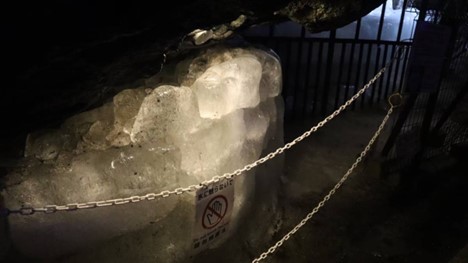
Stacked ice serving as a precursor for what is to come
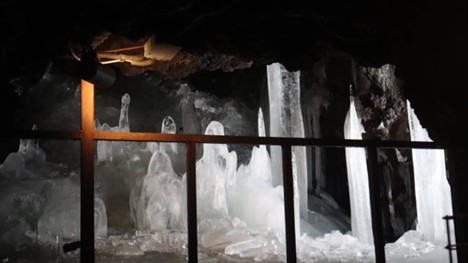
Light being refracted through the ice to reveal pillars of white
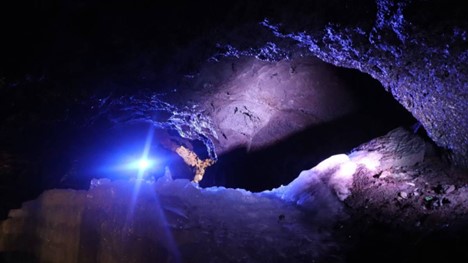
An iridescent, blue light shines behind a wall of ice resembling a beacon atop a mountain
I lacked the ability to discern what every sign said, but with my trusty phone I produced as many janky translations as possible. Over a thousand years ago, Mt. Fuji erupted and the lava that flowed created this cave, the other two caves (Fugaku Wind Cave and Lake Sai Bat Cave), and the area of what the Aokigahara Forest (the area where these three caves are located) would become what it is today. Many years ago, the Narusawa Ice Cave was used as a natural refrigerator. The Fugaku Wind Cave was used to store seeds and silkworm cocoons. In 1929, Japan declared the Narusawa Ice Cave, along with the other two caves, as natural monuments. All three of the caves are within relative distance to each other, and can all easily be visited within a day if you have a car. Unfortunately for me, I took the bus. After having seen all of the frozen water I could, I headed back out the cave.
Upon exiting the cave, I began to feel stuffy in my jacket. I put my jacket back in my backpack and began to notice that this time the sun’s warm embrace actually felt nice due to how cold the cave was. This feeling was short-lived. I ventured back to the entrance, returned my helmet and retreated under some shade. As I looked around for the bus, to my surprise I saw an ice cream sign. Maybe I did not notice it earlier because of the heat exhaustion~ This ice cream place offered corn-flavored ice cream, which I had never known to exist. Of course, I bought the ice cream and waited for the bus to come. It was as if all the fatigue I had been feeling just washed away. Who would have thought that corn and ice cream worked so well together~ The bus eventually came, and as I sat in my seat I reflected on today. Even though I didn’t initially plan to come to the ice cave, it was a fun and enjoyable experience. I don’t usually like to make new plans on the fly. My Mom often calls me a “creature of habit”, but this adventure made me realize that sometimes life’s surprises can become the most memorable experiences.
Griffin Scott
Narusawa Ice Cave Website
Japanese: 鳴沢氷穴 | 富士山の洞窟 天然記念物 富岳風穴・鳴沢氷穴 | 富士山・河口湖 洞窟 観光スポット (mtfuji-cave.com)
English: Narusawa Ice Cave | Travel Japan - Japan National Tourism Organization (Official Site)
References
GaijinPot Travel. “Ice, Wind and Bat Caves of Mount Fuji.” GaijinPot Travel, 12 Dec. 2018, travel.gaijinpot.com/ice-wind-and-bat-caves-of-mount-fuji/.
“Narusawa Hyoketsu Ice Cave: Wind Cave and Ice Cave.” Narusawa Hyoketsu Ice Cave | Wind Cave and Ice Cave, www.mtfuji-cave.com/en/ice_cave/. Accessed 10 July 2023.
Organization, Japan National Tourism. “Narusawa Ice Cave: Travel Japan (Japan National Tourism Organization).” Travel Japan, www.japan.travel/en/spot/201/. Accessed 10 July 2023.
Published on
- May 9, 2024
Share
-
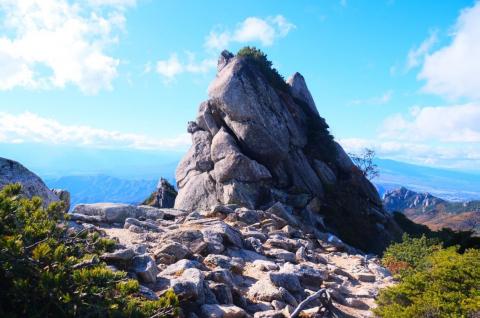
The Golden Peak (金峰山―Kinpusan) of Yamanashi
May 23, 2025
-

May 23, 2025
Home of Mt. Fuji > Kaleidoscope Students Journal > Off the Beaten Path
